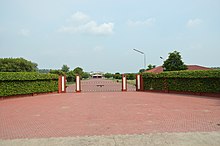Radha Soami
Radha Soami, or Radhasoami Satsang, is a religious organization founded by Shiv Dayal Singh in 1861 on Basant Panchami Day in Agra, India.[1][2][3] It derives its name from the word Radha meaning soul and Soami which refers to True God or One God as swami of His souls as all souls are created by him.[4][5]
The Radhasoamis, states Mark Juergensmeyer, are considered in Punjab as an offshoot of Sikhism, because the teachings of their founder were based, in part, on those of the founder of Sikhism – Guru Nanak and many recite verses from the Adi Granth during their worship.[6] However, they are also different from the Sikhs because they reject the Sikh idea that there are no present day Gurus beyond their first ten, many reject parts or all of the Khalsa Sikh dress code and rituals such as Karah Parshad. The Radhasoamis are a religious fellowship that accepts saints and living gurus from anywhere.[6]
According to Pierluigi Zoccatelli, there were an estimated 3 million Radhasoami followers worldwide in 2004, with many subsects based on the Guru. Of these, the Radha Soami Satsang Beas is the largest[7] and it had 2 million followers.[8] Radhasoami competing subsects have their own headquarters. There are over 30 different Radhasoami groups in the world.[7] The largest group's contemporaneous headquarters are in Beas, with parallel branches found in India and outside India.[1][6][7] Other subsects and movements influenced by Radhasoami include Divine Light Mission, Eckankar, Movement of Spiritual Inner Awareness, Science of Spirituality and others.[8] Some of these groups have tried to distance themselves from the other.[7] Succession upon the death of previous guru has been a source of controversies and schism in the Radhasoami movement since the beginning.[7]



No comments:
Post a Comment